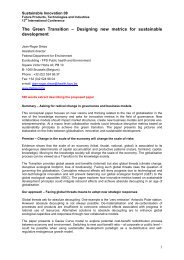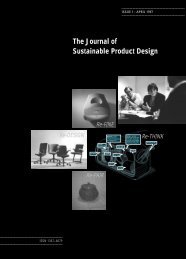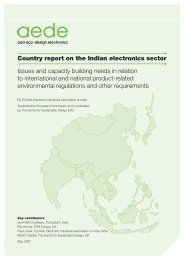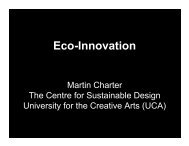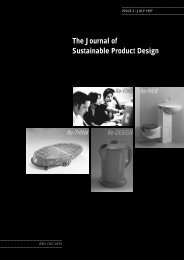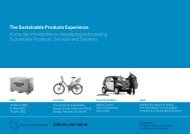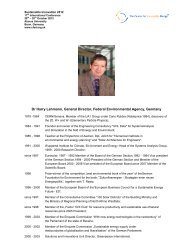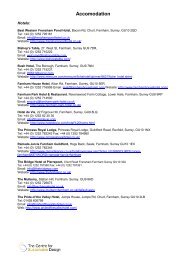acrobat JSPD 8 - The Centre for Sustainable Design
acrobat JSPD 8 - The Centre for Sustainable Design
acrobat JSPD 8 - The Centre for Sustainable Design
You also want an ePaper? Increase the reach of your titles
YUMPU automatically turns print PDFs into web optimized ePapers that Google loves.
groups had to be part of the<br />
process. <strong>The</strong> question then was<br />
how?<br />
Nortel’s environment group<br />
presented a business case to<br />
relevant account teams using<br />
preliminary results from the<br />
market research including an<br />
analysis of all the environmental<br />
queries Nortel had received from<br />
customers over the last 3 years.<br />
This presentation was enough to<br />
encourage the selected account<br />
teams to agree to ‘face to face’<br />
sessions with key customers.<br />
Environmental customer<br />
workshops<br />
Environment teams are accustomed<br />
to running educational<br />
workshops <strong>for</strong> employees on<br />
specific issues, to attending<br />
external workshops, to participating<br />
in stakeholder consultation<br />
and a wide range of<br />
dialogue type activity. This activity<br />
is an excellent methodology<br />
to apply to customer focused<br />
market research. <strong>The</strong> ‘Customer<br />
Environment Workshop’ has the<br />
following aims:<br />
· it explores an environmental<br />
concept in some detail<br />
· it establishes the environmental<br />
values of each<br />
participant<br />
· it is an educational event<br />
<strong>for</strong> all participants<br />
· the facilitator is usually an<br />
expert in environmental and<br />
relevant commercial issues<br />
· experts from both commercial<br />
and environmental perspectives<br />
are present<br />
· there is usually a section of<br />
in<strong>for</strong>med input<br />
· both customer and supplier<br />
are engaged in dialogue.<br />
Those experienced in<br />
stakeholder dialogue processes<br />
will see immediately how this<br />
sort of a process enables all<br />
participants to move <strong>for</strong>ward<br />
together. At the end of the<br />
process:<br />
· the customers are much<br />
better in<strong>for</strong>med about the<br />
issue in hand<br />
· the supplier has a better grasp<br />
of likely market values that<br />
customers will put on environmental<br />
options<br />
· there is (nearly always)<br />
recognition by the suppliers<br />
that the customers do care<br />
· there is (nearly always)<br />
recognition by customers that<br />
the process has given them a<br />
much better understanding of<br />
the issues.<br />
Within the supplier, marketing<br />
and account management teams<br />
involved in the process are much<br />
more likely to take up the environmental<br />
ideas discussed and<br />
build environmental thinking<br />
into their daily processes. environment<br />
teams then have a clear<br />
role as expert advisor to the<br />
marketing teams. <strong>The</strong><br />
Environment teams themselves<br />
acquire a much greater understanding<br />
of the market dynamics<br />
within which their organisation<br />
operates.<br />
<strong>The</strong> customers have usually<br />
provided substantial input to the<br />
supplier, but often perceive that<br />
they have gained even more <strong>for</strong><br />
themselves in terms of enhanced<br />
understanding. A tremendous<br />
amount of goodwill is generated.<br />
JANUARY 1999 · THE JOURNAL OF SUSTAINABLE PRODUCT DESIGN<br />
INNOVATION<br />
In the tradition<br />
of business<br />
speak, the<br />
customer<br />
environment<br />
workshop is a<br />
‘win-win-win’<br />
<strong>for</strong> the<br />
environment<br />
team, the<br />
sales and<br />
marketing<br />
team and the<br />
customers.<br />
55



